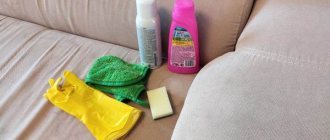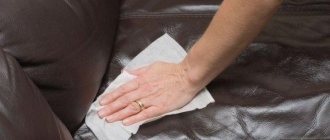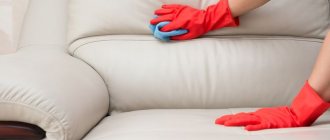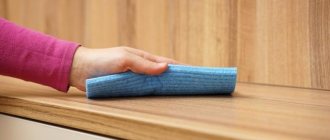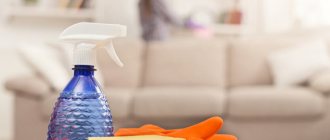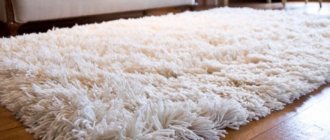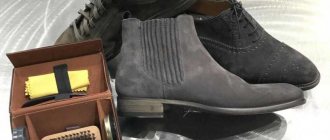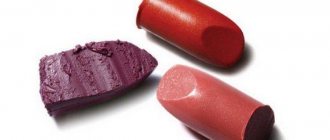Buying light-colored furniture quickly confronts housewives with the problem of cleaning it. On such upholstery, not only dirt, but even the smallest specks of dust, stains, and pet fur become noticeable. In addition, frequently used areas of furniture are very easy to install over oily, untidy spots. To prevent the sofa from becoming a reflection of everyday life, it is recommended to clean it regularly using suitable household cleaning methods. Only timely and proper care can preserve the beauty and tone of the upholstery, making the results of use inconspicuous.
Surface preparation
Before you start cleaning your sofa at home, you need to do the following:
- Decide on the type of detergent. What is suitable for leather furniture is sometimes not recommended for use on models with fabric upholstery and vice versa.
This is the most important point; not only the result of home cleaning, but also the safety of the sofa surface will depend on it, so when choosing a product (improvised or industrial), strictly follow the recommendations for its use.
- Thoroughly vacuum the fabric surface or wipe with a soft cloth if the sofa is made of genuine leather or substitutes. This stage should never be skipped, since by ignoring it, you can add dirty stains to the existing stains, which will then be problematic to remove from light-colored furniture.
- Pre-treat existing stains with special products. If the sofa does not have pronounced stains, then you can immediately begin cleaning with the chosen product.
Thus, in order to clean the sofa without streaks, you need to choose the right product that will not damage the surface and tidy up the upholstery.
Leather sofas and microfiber models are the most resistant to stains and streaks and are easy to care for, unlike capricious materials such as jacquard or tapestry.
Some upholstery is specially impregnated with compounds that repel dirt and thereby make the furniture easier to care for.
Cleaning steps
Such a serious undertaking as cleaning light-colored furniture at home requires a competent approach and a little preparation.
- Surface preparation
First, you should free the coating from dust. This step can be skipped if you only need to clean small local contaminants. But, if you tackle the problem thoroughly, then first the upholstery of upholstered furniture should be freed from accumulated dust, and at the same time from wool or crumbs lying around, etc.
- Vacuuming
If you have a vacuum cleaner at home, then you simply need to vacuum the upholstery, paying special attention to all corners and joints. You can use a special furniture nozzle (preferably with a brush) or just a dust collection tube.
- Punching through fabric
If the family does not have a vacuum cleaner or the sofa upholstery is made of velor, velvet, or other fleecy material, then the dust is simply knocked out in the following way:
- prepare an old sheet and a carpet beater;
- moisten the sheet in water or soapy water and wring it out a little;
- cover furniture with damp cloth;
- carefully knock out the dust, not missing any corners.
This way you can free the sofa from dust without polluting the air space.
- Manual method
In case of heavy contamination, you can carefully remove solid dirt. You can also scrape off dirt with the butt of a knife, spatula, or other object with a blunt edge. Hardened debris should not be scraped off from materials with pile (flock, leather or chenille). They must first be soaked in soap suds and then removed.
- Preparation of funds
It is quite productive to use a special shampoo with a whitening effect to clean furniture. But you can make such a solution yourself.
How to clean a fabric sofa
Before cleaning, it is better to test all products for treating upholstered furniture without exception in hidden places (under or behind the sofa).
It is imperative to take into account each condition for processing individual upholstery materials.
Flock.
Before cleaning a flock sofa, you need to make sure that the product you choose does not include ethanol. Immediately after cleaning, you can go over the upholstery with a soft-bristled brush to smooth out the lint.
Microfiber.
To clean a microfiber sofa at home, you must use only dry methods. Wet cleaning is only possible in extreme cases.
Advice! To clean a snow-white sofa, you should use only white rags. Multi-colored fabric under the influence of detergents can color light-colored upholstery. Do not use bleach or pure vinegar.
Basic cleaning rules
In general, caring for polished furniture is not much different from other interior items. The only difference is the availability of specialized cleaning products and tools.
To effectively clean products from various contaminants, water, flour, salt, milk, vinegar, gasoline, liquid soap, alcohol, raw potatoes, vegetable oils and other substances are useful. For equipment, use soft fabrics, cotton swabs, pieces of leather, a knife and water containers.
A special furniture spray may be useful.
If you have no idea how and how to effectively clean polished furniture at home, use proven recipes that give good results:
- A solution prepared on the basis of an antistatic agent, shampoo and water - thanks to it there will be much less dust.
- Wine vinegar and olive oil.
- Beer boiled with a piece of wax.
- Tea brewing - gives the surface its former freshness.
- Milk.
Tea brewing
All products are used in the same way: prepare the mixture, moisten a rag in it and rub the furniture, and finally walk with a dry cloth.
Any dirt that appears on polished furniture can be removed with a cloth soaked in a soap solution. After processing, rub the coating with woolen material or felt.
If there are fingerprints on the product, wipe them with talcum powder or raw potatoes cut in half. For more severe stains, other recipes are needed. One of the best remedies is vegetable oil. Drop it onto a cotton swab and thoroughly treat all contaminated areas. After this, remove the product with a damp cloth and rub the surface of the furniture with a dry soft cloth.
To quickly and easily remove stains, it is recommended to first sprinkle them with flour and then grease them with oil. It can also be mixed with ethyl alcohol. If there are traces of an iron or other hot object on the furniture, wrap it in a light cloth, moisten it with sunflower oil and wipe the stains. Finally, polish the surface. You can apply a mixture of salt and oil to the problem area, leave for a couple of hours and remove.
Vinegar and vegetable oil help with old stains
Vinegar gives good results. Warm it up, dampen a cloth and treat the dirt, then wipe dry and polish using wax or colorless shoe polish. Another option - sauerkraut brine - is used in a similar way.
If you find candle drops on the furniture, heat a knife in boiling water and use the blunt side to carefully remove the wax, then soak a rag in gasoline and rub the remaining stain. Heated beer can easily remove the ink. You can also buy a specialized polish care product and use it according to the instructions.
Almost all methods of cleaning products at the final stage involve polishing the furniture, which is not so difficult to do at home. For natural wood you will need wax, the color of which matches the shade of the surface. Apply it to a soft cloth and rub in in a circular motion. Start with large areas and finish with small details. You should not take a large amount of the composition, otherwise it will lie unevenly, and faded spots will appear on the surface.
Polishing is done using wax
Antique chests of drawers can be polished with natural wax. Warm it up, apply with a wide brush and thoroughly polish the wood. For modern furniture made from veneer, oil-based liquid polishes are suitable. Spray the product, spread it with a soft cloth and polish. If desired, you can use a simple home recipe. Mix drying oil and turpentine, pour the mixture into a tightly closed container. Periodically apply it to the furniture and rub with a woolen cloth until it shines.
Regular and competent care of polished furniture will prevent its contamination and damage. When cleaning products, you should follow some rules:
- If there is an allergy sufferer in the family, do not use chemicals - in this case, only natural substances will help.
- Only soft materials are suitable for wiping furniture: wool, flannel or velvet. They do not scratch the surface.
- Dust from the threads should be removed with a brush.
- Do not place hot objects on the polished surface - use stands for them.
- For cleaning, you should not use acetone and alcohol - because of them, the furniture loses its shine.
If polished items have darkened or changed color, wipe off the dust, rinse and dry with a soft cloth. Then treat with a solution made from turpentine and linseed oil. All actions must be performed quickly so that the coating heats up. This will allow the oil to react with other ingredients, oxidize, and return the shine to the polish.
Simple and accessible recipes will help remove dirt and stains that have appeared on polished furniture and restore it to its former beauty and shine. The main thing is to follow the described rules, and then your home will always be in order.
Good housewives never forget to take care of their spacious closets and favorite chests of drawers. It’s not complicated at all - it’s just important to remember that when dealing with an unvarnished wooden surface, you can’t use oil products. This will protect your furniture from greasy stains. And never use products intended for polished furniture - they will leave greasy stains on the wood that will not be easy to remove.
Rules of care
Of course, unpolished wood is good - it looks natural and aesthetically pleasing, but, alas, it is very susceptible to all kinds of dirt. Ideally, caring for unpolished furniture should be done daily. It is advisable to vacuum the unpolished surface using a soft-bristled attachment. This will rid the wood surface of dust accumulations, which, penetrating into the smallest cracks, give the furniture an ugly grayish tint - dull and untidy. If the moment was missed and the furniture still became dirty, wipe it first with a damp and then with a dry cloth. Wipe off heavy stains with soapy water, quickly removing any traces of it with a clean, dry cloth.
Caring for unpolished furniture in light shades: . melt a white wax candle in a water bath; . mix wax with gasoline/white spirit (1:1); . Apply the cooled mixture to the furniture (for 2-3 hours); . polish with a flannel cloth.
Restoring old furniture
If unpolished furniture is not properly cared for, it has every chance of losing its original attractiveness and becoming unpresentable and neglected. To refresh old furniture, follow the steps below:
Take a damp cloth and wipe off the dirt thoroughly. . Wipe the furniture with a dry cloth, carefully removing moisture. . Make a composition. Place the finely chopped wax in a bottle, fill it with turpentine, seal it and put it in hot water. When the wax melts, shake the bottle so that the composition becomes homogeneous. . Apply the prepared composition to unpolished wood - use a brush or cotton swab. After a day, vigorously treat the wood with a cloth or piece of woolen cloth.
How to remove grease stains?
One of the most troublesome parts of caring for unpolished furniture is fighting stains. It is not easy to remove greasy stains from unpolished wood; usually, a mixture of alcohol and drying oil (1:1) is used. The composition is applied with a flannel swab. Then rub the contaminated area until the stain disappears. After drying, polish the wood with flannel.
How to remove blisters and dents?
If, while caring for unpolished furniture, you find a dent, do not be alarmed. To eliminate them, it is enough to carry out a simple “turpentine” rehabilitation: . wipe the dent with turpentine; . Place wet gauze, folded in four, over the dent, and a metal bottle cap (smooth side down) on top of it; . Press down the cork with a hot iron.
Blisters, often caused by high humidity, are removed as follows: . Small blisters are ironed with a heated iron through paper folded in several layers. . Large swellings are pierced with an awl and furniture glue is injected into the hole - for this you can take an insulin syringe. Place paper on top and iron it. Pressing the swollen area with a weight, leave it for 2-3 days.
Reading time: 4 minutes. Published 10/05/2018
It is difficult to imagine a living space without upholstered furniture. The sofa and armchairs are symbols of home comfort and family warmth. Due to active use, upholstered furniture easily becomes dirty, which creates additional difficulties when cleaning.
Not all housewives know how to clean upholstered furniture at home. There are several secrets that help make caring for her easier.
Types of stains and methods for removing them
To remove stains from the surface of the upholstery, you can try a universal home method that is suitable for absolutely all types of materials. This is soap suds or a solution of detergent for cleaning carpets. It is necessary to apply the foam to dirty areas, let it work for 15-20 minutes, and then wash the coating clean, removing excess water with a rag.
If the stain still remains, try to remove it using the following compounds:
- 2 tbsp. l 9% vinegar per 1 liter of water;
- a solution of shampoo in water with the addition of 10–11 drops of ammonia.
In most problematic situations, these simple operations are quite enough to free the upholstery from stains of tea or coffee, chocolate or white wine, as well as beer, jam, cola, etc.
If these home methods are not enough, then you should resort to more effective methods that are used separately for each category of pollution.
Blood
Fresh blood stains should be immediately moistened with cool water until they disappear completely. If the stain is already old, then it can be kept under ice cubes, after wetting it with a weak solution of vinegar (2 tablespoons of vinegar per 1 liter of water). Finish the treatment with soapy water and dry.
Fruit or vegetable juices
Apply a mixture of ammonia and 9% vinegar to the stain, then wash the surface with a clean, wet cloth.
Red wine
Blot the fresh wine stain with a napkin and cover with fine salt. Give the salt a little time to absorb the water, then shake it off with a soft-bristled brush and wash the stain with ethyl alcohol, and then with soap suds. At the end of the treatment, remove parts of the soap with water and dry the cleaning area with napkins.
Ink, markers, or lipstick marks
Easily cleaned with simple acetone or ethyl alcohol. You can also remove ink and marker stains with women's hairspray.
Gum
Removed by freezing with ice cubes. The remaining stain can be wiped with alcohol and dried.
Fat
Grease stains must be covered with salt for a while. Then the fat is easily washed off with a solution of any dishwashing detergent.
Dust
If, after cleaning with a vacuum cleaner, untidy stains and stains remain on the light-colored upholstery, you should wash them with a solution of any hair shampoo, which will completely remove all dirt.
Household chemicals
Washing a light or white sofa is a rather difficult task, since any wrong tactics can lead to negative consequences. That is why the greatest guarantee of effective and safe cleaning is provided by manufacturers of household chemicals. In the assortment you can find a variety of products:
- shampoos for specific materials;
- sprays for cleaning chenille, tapestry, matting, silk, cotton and other fabrics;
- gels for restoring the color and structure of upholstery;
- active foam to remove surface stains and add freshness to a light-colored sofa.
Among active Internet users who happily share their impressions of using a particular tool, the most positive reviews were collected by:
- “Vanish” - for carpets and upholstered furniture, as well as active foam and stain removers;
- "Shtihonit" from - spray for removing stains and cleaning upholstery of upholstered furniture;
- “Grass” - for cleaning carpets and upholstered furniture;
- "Arnest" for carpets and upholstered furniture "Shine";
- for cleaning carpets and upholstered furniture "Procarpet".
Important! Before applying the product to the main upholstery, be sure to test its effect on an inconspicuous area of the sofa.
It is advisable to choose any store-bought cleaning product for a light and white sofa based on the type of material and type of contamination.
Traditional methods for cleaning greasy upholstery on upholstered furniture
Greasy marks and abrasions that appear on the surface of the sofa during use can be removed using folk remedies.
In every kitchen there is vinegar, soda or salt, and in the bathroom there is laundry soap or shaving foam. Some housewives have ammonia in their medicine cabinet. All of these products can be used to clean upholstery.
Before choosing a recipe, consider the type of sofa upholstery. Not all fabrics can be wetted or scrubbed with a brush.
Salt
- Old stains are removed with a strong saline solution.
- Dissolve 2 tablespoons of salt in a liter of warm water.
- The composition is applied to the stain and after a third of an hour is removed with a slightly damp sponge.
- Stains that have appeared recently can be sprinkled with salt. After 15-20 minutes it is removed with a vacuum cleaner.
Soda
Sodium chloride helps remove grime from sofa upholstery. There are several ways to do this:
- Blot the stains with a damp sponge or cloth and sprinkle with baking soda. After 30 minutes, wipe the upholstery with a brush or microfiber cloth. Wait until the treated areas dry and vacuum the sofa. Use a damp sponge or cloth to wipe the surface.
Rinse them as often as possible - this will eliminate streaks.
- Old stains can be removed with soda paste. It is mixed with water in a 1:1 ratio. Apply to the worn area and gently rub into it with a soft bristle brush. After an hour, if the sofa is dry, it is vacuumed. Remains of soda are removed with a damp sponge or cloth.
- A mixture of baking soda, water and dishwashing liquid can remove heavy stains. Mix two tablespoons of baking soda and detergent in a liter of water. Stir and apply foam to problem areas. After 15 minutes, the composition is removed with a damp cloth.
Vinegar and soda
A mixture of 9% vinegar with the addition of soda gets rid of grease and returns brightness to the upholstery.
What you will need:
- Spray bottle with a capacity of 1 liter.
- 100 milliliters of vinegar.
- 0.5 liters of water.
- A tablespoon of soda.
Add vinegar and soda to the water. Screw on the spray bottle. Spray the mixture onto the upholstery. Leave for 10 minutes. The solution is removed using a soft cloth or foam sponge.
If necessary, it is reapplied. After the stains have been removed, wipe the treated area with a cloth soaked in clean water.
Laundry soap
You can remove scuff marks from the armrests, back or seat of the sofa using laundry soap.
What you will need:
- Capacity of more than 5 liters.
- Grater.
- A piece of laundry soap.
- Rag or brush.
You need to grate the soap, dissolve the shavings in water, and whip up the foam. Rub it onto problem areas and leave for 10 minutes. Wipe gently with a brush or microfiber cloth.
If you don’t want to bother with soap shavings, you can lightly moisten the greasy area with a spray bottle and rub it with laundry soap. Leave the product for 10 minutes, then remove with a damp cloth and brush.
This method requires less preparation time. It will take a little longer to remove soap from the sofa. Upholstery made from pile fabrics should only be cleaned in the direction of the pile.
Ammonia
- To clean upholstery from grime, you can use ammonia:
- It is diluted with water 1:1.
- Stains are wiped with a cosmetic disc or soft cloth.
- After the grime has been removed, the surface is wiped with a damp, clean cloth.
Shaving foam
You can remove dirt from light-colored upholstery using shaving foam. A small amount is applied to the stains and gently rubbed in with your hand.
After 20-30 minutes, the foam is removed with a damp sponge, then the sofa is wiped with a dry microfiber cloth.
On old stains, the product can be left overnight. They start cleaning the sofa from the back, then move on to the seats, then the armrests.
Chemicals
In addition to folk remedies, you can also buy chemical cleaners in stores. Such means of cleaning a sofa at home have their advantages:
- Easy to use: the product is completely ready
- Fast acting: usually a few minutes are enough
However, they also have disadvantages:
- May cause allergies
- Corrodes fabric and dyes
These products contain artificial industrial substances, fragrances and harsh ingredients - all of which can cause coughing, sneezing, skin rashes or a runny nose. Considering that the substances are applied to a large area of furniture, the effect of allergens becomes very strong.
The second disadvantage of chemistry is that the composition is too aggressive. Regular use of these substances will discolor paints and corrode upholstery. It makes sense to use such products only in rare cases - when you need to quickly wipe off heavy dirt.
Removal technique
There are three ways to get rid of stains on your sofa upholstery yourself, such as:
- use of improvised means;
- treatment with a washing vacuum cleaner;
- use of specialized industrial preparations.
The withdrawal process includes several steps:
- Treating the surface of the sofa with a vacuum cleaner, preventing the formation of dirty stains due to dirt and dust accumulated in the structure of the fabric.
- Preparation of the working solution and preparation of all accessories necessary for cleaning. To remove stains, you will need a sponge, a container of clean water, paper towels, cloth napkins, and personal protective equipment.
- Apply cleaning agent to the problem area.
- Waiting (the duration is indicated in the description of the cleaning technology).
- Clean dirt with a sponge or soft brush.
- Completion of the procedure is the removal of residual dirt and cleaning agent. Clean with a vacuum cleaner or a clean, slightly damp cloth.
- Thoroughly dry the cleaned area (naturally or using a hair dryer).
Important! Fabrics with a fleecy surface do not tolerate brushing or excessive mechanical impact during friction. Ignoring this rule causes the pile to roll off, causing a bald spot to form on the upholstery.
How to clean upholstered furniture at home
Cleaning methods are divided into dry and wet. Different methods are used depending on the complexity of the dirt, the frequency of cleaning and the time allocated for cleaning.
In addition to the sofa, you also need to regularly care for:
- Armchairs
- Chair seats
- Cushions and poufs
People often forget to clean such furniture, but dust and pet hair also accumulate here, which becomes a breeding ground for infections and bacteria. As a rule, dry cleaning is used to care for small upholstered furniture.
Dry cleaning
This method is the simplest, as it does not require the preparation of special solutions or drying of furniture. Dry cleaning is recommended once a week. For it they use:
- Brush
- Vacuum cleaner
- A spatula for knocking out.
The easiest way to care for furniture is with a brush. A product with stiff bristles is suitable for this. The brush cleans velor, pile, and fur capes well.
It makes sense to use a vacuum cleaner for tapestry or matting. It is effective to combine cleaning with a vacuum cleaner and a brush.
Wet cleaning
Wet cleaning is recommended once a month. This rhythm will allow you to keep your upholstered furniture always neat and new. Regular wet cleaning will protect against the appearance of severe grime and old stains.
Wet cleaning has one feature - after it you need to dry the furniture, otherwise mold will grow in it. You can cover the sofa with a blanket, blanket or cape only after it has completely dried.
There are different ways to dry furniture:
- Vacuum cleaner
- Dry towels
- Hairdryer
- Natural drying
A vacuum cleaner uses air circulation to help moisture evaporate faster. This allows the sofa to dry naturally. At the same time, it helps remove moisture from deep layers if it gets there.
Dry towels help dry only the top layer of upholstery. To do this, they are laid out on furniture and removed after 1-2 minutes. The procedure can be repeated several times.
Use a hairdryer to dry deep and heavily moistened areas. It is usually used when something has been spilled on a product. In this case, it is better to dry with cold air. High temperatures can dry out the filling of sofa cushions.
When drying, the hair dryer should also not be brought too close to the product; it is better to keep it at a distance of 20-30 cm.
It is better to carry out natural drying with the windows open - this way the furniture will dry faster. They always complete all drying procedures. However, this method is not so fast.
General rules and recommendations
Different types of textiles and the origin of stains require a special approach to cleaning. However, there are several uniform rules, the observance of which significantly improves the result. Namely:
- Vacuuming upholstered furniture before removing stains using a turbo brush or a special attachment. This will remove dust, small debris and wool.
- Testing the selected product before use. To do this, the drug is applied to an area of the upholstery hidden from view.
- Avoiding over-hydration. Cleaning the sofa with soap foam, rather than the solution itself, will help prevent the occurrence of dampness, mustiness and mold.
- Using wet wipes that can effectively remove small stains from textile upholstery.
- Timely removal of stains, preventing the penetration of dirt into the fiber structure.
- High-quality drying of furniture after cleaning (preferably in a natural way). In damp and cold weather, it is advisable to use a hairdryer for this purpose.
- Use only non-aggressive industrial preparations, since exposure of upholstery material to chemicals most often leads to its damage.
Pollution prevention
To avoid stains, it is recommended to use capes, blankets or covers. In any furniture store they are presented in a wide range. These capes are easy to remove and wash. In addition, they can be shaken out regularly, which will rid the apartment of dust, pet hair and bacteria.
The use of capes and bedspreads is not only hygienic, but also allows you to periodically change the interior.
Folk recipes for cleaning a sofa with baking soda at home
Dry cleaning.
For removing light stains and unpleasant odors (urine, beer), for cleaning a light-colored sofa or delicate upholstery that does not like moisture
- Sprinkle dry soda thickly onto the contaminated area of the sofa or the entire upholstery.
- Leave for about an hour.
- Remove the soda with a vacuum cleaner.
- If the smell remains, you need to repeat the procedure.
Wet processing.
To remove grease, refresh color, to treat the entire sofa or its individual parts, to remove stains from tea, coffee, dirt, paint, ballpoint pens
- Dampen a clean sponge with water and wipe the upholstery with it. The fabric should become damp.
- Sprinkle the sofa generously with dry soda.
- Leave everything for half an hour.
- Rub the upholstery with a soft furniture brush or dry cloth. Pay special attention to the most contaminated areas.
- Allow the sofa to dry completely (this will take up to two hours).
- Vacuum the fabric thoroughly.
- Wipe the upholstery with a damp sponge or cloth to remove any remaining soda. Rinse the sponge frequently in clean water.
- Dry the clean sofa.
Cleaning with soda slurry
This method also helps remove grease, tea, coffee and dirt stains. It is more effective, but also more complex to implement than the previous one.
- Mix soda with water (1:1).
- Spread the resulting pulp evenly over the surface of the sofa.
- Rub the product into the upholstery with a soft, short-bristled brush.
- Leave everything for an hour. The sofa should be completely dry during this time.
- Vacuum the upholstery. If necessary, wipe it with a damp cloth to remove any remaining soda.
Cleaning with soda solution
This method is suitable for quickly cleaning a sofa from light stains with baking soda. Suitable only for upholstery that is not afraid of moisture.
- Prepare a cleaning solution – 2 tbsp. l soda per liter of water.
- Pour it into a spray bottle and spray it over the upholstery of the sofa.
- More contaminated areas can be moistened with more solution and rubbed with a brush. Then remove excess moisture with a clean sponge.
- Allow the upholstery to dry completely and vacuum it.
General cleaning with baking soda and detergent.
To remove heavy dirt, stubborn stains, and traces of urine.
- Mix a liter of water, 2 tbsp. l. soda and 2 tbsp. l. dishwashing detergents, for example, “Fairy”. Instead of detergent, you can use laundry soap or colorless shampoo.
- Lather the solution with a sponge or hand.
- Apply foam to sofa upholstery.
- Leave everything for 5-10 minutes.
- Rinse off cleaning products thoroughly with a sponge and clean water.
Powerful cleaning of the sofa with soda, vinegar and Fairy.
- An even more effective product for general cleaning and removing the toughest stains
- You need to mix 1 tsp. “Fairy”, about 150 ml of vinegar (9%) and half a liter of hot water.
- It is more convenient to pour the solution into a spray bottle, but it can also be prepared in a basin.
- Lastly, add 1 tbsp. l. soda The mixture will foam.
- Spray the sofa with a solution from a spray bottle or moisten it with a sponge.
- Scrub all upholstery or the most dirty areas with a brush.
- Rinse off the dirty solution with clean water.
Cleaning the sofa with alcohol and soda.
For removing fresh grease stains
- Sprinkle a thick layer of baking soda on the stain.
- Wait one to two hours. If there is a lot of fat, you should remove the soda as soon as it is soaked and add fresh.
- Remove dirty baking soda with a brush or vacuum cleaner.
- Wipe the remaining stain with a cotton pad soaked in alcohol.
Cleaning the sofa with baking soda and peroxide.
- For removing stains from fruits, berries, juices, “colored” vegetables, wine, tea and coffee
- Mix soda and hydrogen peroxide (3%) in a ratio of 1:2.
- Apply the solution to the stain and wait until it discolors. Be careful as peroxide can also bleach the dyes in the fabric itself.
- Remove the product from the upholstery with a damp sponge.
- Rinse the fabric and dry the sofa.
Cleaning a leather sofa.
For removing shiny stains from leather, eco-leather and leatherette
- Prepare a soap-soda solution (1 tablespoon of grated laundry soap and baking soda per liter of warm water).
- Soak a sponge or soft flannel in the cleaning solution, wring it out and gently wipe off the dirt.
- Wipe the treated areas with a cloth soaked in clean water and then with a dry towel.
- After cleaning, be sure to apply a protective agent (conditioner) to care for the leather on the sofa.
We looked at the best methods and talked about how to clean the sofa upholstery from grease, dirt, and grease.
If you have tried everything, but the stain cannot be removed, then contact a dry cleaner, whose specialists will come to your home with all the necessary equipment and chemicals.
How to clean a white leatherette sofa?
As a rule, furniture made of leatherette or eco-leather is more difficult to remove stains. In addition, when treating a stain, you should adhere to some rules:
- — do not use harsh and abrasive substances, as is the case with natural leather;
- - do not use too much water;
- - do not dry in direct sunlight;
- - do not use products containing acetone, chlorine and 100 percent alcohol;
- - After removing the stain, wipe the surface dry with a soft cloth.
Products such as nail polish remover, hydrogen peroxide, and lemon juice will help remove most stains from a white sofa. However, they will not always give 100% results. Most often, in the case of leatherette, special means will be more effective.
If home remedies are powerless against this or that contamination, then there is another reliable option - cleaning the leather sofa by specialists from cleaning companies. So, professionals will help restore a leather sofa, as well as furniture made from white eco-leather and apatek, to its original whiteness and freshness.
